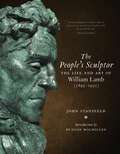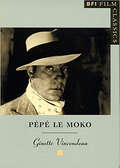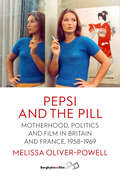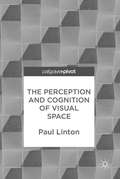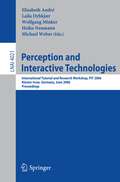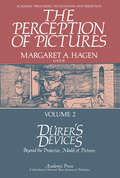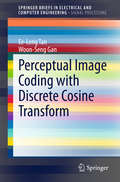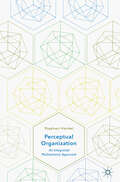- Table View
- List View
The People's Sculptor: The Life and Art of William Lamb
by John StansfeldTracing the life and work the life of Scottish sculptor William Lamb (1893 - 1951) this is a story of indomitable will and irrepressible creativity. The son of an alcoholic father and a survivor of the 'lost generation' who came of age in 1914, it was with courage and determination that Lamb overcame the obstacles life put in his path. Traumatised in the trenches at Passchendaele during the First World War and blighted by depression, Lamb was also severely wounded in his right hand. With characteristic resolve he retrained with his left hand - at Edinburgh College of Art and the Ecole des Beaux Arts in Paris. Despite the uncertainty of an art market rocked by world war, Lamb established his reputation in Montrose with sculptures of the townspeople and fishermen of east Scotland. He produced prints, water colours and drawings to help fund his sculpture. Occasionally he undertook commissions and in 1932 he completed portrait bronzes of the young Princesses Elizabeth and Margaret. The Second World War dried up his supplies of materials, so he turned to wood carving and, when death finally put an end to his creativity, he left a large collection of his artwork as a legacy to the Scottish people.
The People's Stage in Imperial Germany: Social Democracy and Culture 1890-1914
by Andrew BonnellThis book examines the history of the Freie Volksbuhne (Free People's Theatre), Berlin, from 1890-1914, in the light of the cultural theory and practice of German Social Democracy in Imperial Germany.The clash between German Social Democracy – the party, intellectuals and workers – and the German Imperial State was played out in the Freie Volksbahne (Free People's Theatre) founded by intellectuals to energize working class political awareness of drama with a political and social cutting edge. It fell foul of state censorship, lost its bite, yet prospered.The book looks in detail at the various programmes guiding the Volksbuhne's work and at the reception of the plays by the largely working-class audience, to offer a detailed study of the interactions between cultural and political history in Imperial Germany.
Pepe le Moko (BFI Film Classics)
by Ginette VincendeauVincendeau's analysis places 'Pepe le Moko' in its aesthetic, generic and cultural contexts, ranging from Duvivier's brilliant camera-work, to Gabin's suits and the film's orientalist setting. In the BFI FILM CLASSICS series.
Pepe le Moko (BFI Film Classics)
by Ginette VincendeauVincendeau's analysis places 'Pepe le Moko' in its aesthetic, generic and cultural contexts, ranging from Duvivier's brilliant camera-work, to Gabin's suits and the film's orientalist setting. In the BFI FILM CLASSICS series.
Pepsi and the Pill: Motherhood, Politics and Film in Britain and France, 1958–1969
by Melissa Oliver-PowellThe 1960s was a decade of massive political and cultural change in Western Europe, as seismic shifts took place in in attitudes towards sexuality, gender, and motherhood in everyday life. Through case studies of British and French films, Pepsi and the Pill offers a fresh vision of a pivotal moment in European culture, exploring the many ways in which political activity and celebrated film movements mutually shaped each other in their views on gender, sexuality, and domesticity. As the specter of popular nationalism once again looms across Europe, this book offers a timely account of the legacy of crucial debates over issues including reproductive rights, migration, and reproductive nationalism at the intersection of political discourse, protest, and film.
Pepsi and the Pill: Motherhood, Politics and Film in Britain and France, 1958–1969
by Melissa Oliver-PowellThe 1960s was a decade of massive political and cultural change in Western Europe, as seismic shifts took place in in attitudes towards sexuality, gender, and motherhood in everyday life. Through case studies of British and French films, Pepsi and the Pill offers a fresh vision of a pivotal moment in European culture, exploring the many ways in which political activity and celebrated film movements mutually shaped each other in their views on gender, sexuality, and domesticity. As the specter of popular nationalism once again looms across Europe, this book offers a timely account of the legacy of crucial debates over issues including reproductive rights, migration, and reproductive nationalism at the intersection of political discourse, protest, and film.
Perception and Agency in Shared Spaces of Contemporary Art (Routledge Advances in Art and Visual Studies)
by Cristina Albu Dawna SchuldThis book examines the interconnections between art, phenomenology, and cognitive studies. Contributors question the binary oppositions generally drawn between visuality and agency, sensing and thinking, phenomenal art and politics, phenomenology and structuralism, and subjective involvement and social belonging. Instead, they foreground the many ways that artists ask us to consider how we sense, think, and act in relation to a work of art.
Perception and Agency in Shared Spaces of Contemporary Art (Routledge Advances in Art and Visual Studies)
by Cristina Albu Dawna SchuldThis book examines the interconnections between art, phenomenology, and cognitive studies. Contributors question the binary oppositions generally drawn between visuality and agency, sensing and thinking, phenomenal art and politics, phenomenology and structuralism, and subjective involvement and social belonging. Instead, they foreground the many ways that artists ask us to consider how we sense, think, and act in relation to a work of art.
The Perception and Cognition of Visual Space
by Paul LintonThis book explores a central question in the study of depth perception - 'does the visual system rely upon objective knowledge and subjective meaning to specify visual depth?' Linton advances an alternative interpretation to the generally accepted affirmative answer, according to which many of the apparent contributions of knowledge and meaning to depth perception are better understood as contributions to our post-perceptual cognition of depth. In order to defend this position a new account of visual cognition is required, as well as a better understanding of the optical and physiological cues to depth. This book will appeal to students and researchers in psychology, vision science, and philosophy, as well as technologists and content creators working in virtual and augmented reality.
The Perception and Cognition of Visual Space
by Paul LintonThis book explores a central question in the study of depth perception - 'does the visual system rely upon objective knowledge and subjective meaning to specify visual depth?' Linton advances an alternative interpretation to the generally accepted affirmative answer, according to which many of the apparent contributions of knowledge and meaning to depth perception are better understood as contributions to our post-perceptual cognition of depth. In order to defend this position a new account of visual cognition is required, as well as a better understanding of the optical and physiological cues to depth. This book will appeal to students and researchers in psychology, vision science, and philosophy, as well as technologists and content creators working in virtual and augmented reality.
Perception and Imaging: Photography as a Way of Seeing
by John Suler Richard D. ZakiaWhen you look at an image, what do you see and feel? What do you want your audience to see and feel when they view your work? For over thirty years, Dr. Richard Zakia helped thousands of photographers hone in on their creative vision through the inspirational, informative text and images included in his classic book, Perception and Imaging. More than a step-by-step photography instruction manual, Perception and Imaging explores the fundamental act of photography – seeing – through a uniquely comprehensive combination of technique, history, visual perception, philosophy and psychology. No matter your level of technical skill, you can learn to think more clearly about what you wish to convey in your images. Fully revised to account for the unique influences and consequences of the digital revolution and online photosharing, John Suler newly addresses digital impermanence, sensory and cognitive overload, and the selfie, and their effects on perception. Additional coverage also includes microexpressions, Rorschach inkblots and subliminal reactions, transference, and synectics.
Perception and Imaging: Photography as a Way of Seeing
by John Suler Richard D. ZakiaWhen you look at an image, what do you see and feel? What do you want your audience to see and feel when they view your work? For over thirty years, Dr. Richard Zakia helped thousands of photographers hone in on their creative vision through the inspirational, informative text and images included in his classic book, Perception and Imaging. More than a step-by-step photography instruction manual, Perception and Imaging explores the fundamental act of photography – seeing – through a uniquely comprehensive combination of technique, history, visual perception, philosophy and psychology. No matter your level of technical skill, you can learn to think more clearly about what you wish to convey in your images. Fully revised to account for the unique influences and consequences of the digital revolution and online photosharing, John Suler newly addresses digital impermanence, sensory and cognitive overload, and the selfie, and their effects on perception. Additional coverage also includes microexpressions, Rorschach inkblots and subliminal reactions, transference, and synectics.
Perception and Interactive Technologies: International Tutorial and Research Workshop, Kloster Irsee, PIT 2006, Germany, June 19-21, 2006 (Lecture Notes in Computer Science #4021)
by Wolfgang Minker Heiko Neumann Michael Weber Elisabeth André Laila DybkjærThis book constitutes the refereed proceedings of the International Tutorial and Research Workshop on Perception and Interactive Technologies, PIT 2006, held at Kloster Irsee, Germany, June 2006. The book presents 16 revised full papers together with 4 revised poster papers and 6 system demonstration papers, organized in topical sections on head pose and eye gaze tracking, modeling and simulation of perception, integrating information from multiple channels, and more.
Perception, Design and Ecology of the Built Environment: A Focus on the Global South (Springer Geography)
by Mainak GhoshThis edited volume is a compilation of the ‘built environment’ in response to many investigations, analyses and sometimes mere observations of the various dialogues and interactions of the built, in context to its ecology, perception and design. The chapters concentrate on various independent issues, integrated as a holistic approach, both in terms of theoretical perspectives and practical approaches, predominantly focusing on the Global South. The book builds fabric knitting into the generic understanding of environment, perception and design encompassing ‘different’ attitudes and inspirations. This book is an important reference to topics concerning urbanism, urban developments and physical growth, and highlights new methodologies and practices. The book presumes an understanding unearthed from various dimensions and again woven back to a common theme, which emerges as the reader reads through.Various international experts of the respective fields working on the Global South contributed their latest research and insights to the different parts of the book. This trans-disciplinary volume appeals to scientists, students and professionals in the fields of architecture, geography, planning, environmental sciences and many more.
Perception in Multimodal Dialogue Systems: 4th IEEE Tutorial and Research Workshop on Perception and Interactive Technologies for Speech-Based Systems, PIT 2008, Kloster Irsee, Germany, June 16-18, 2008, Proceedings (Lecture Notes in Computer Science #5078)
by Elisabeth André Laila Dybkjær Heiko Neumann Roberto Pieraccini Michael WeberThis book constitutes the refereed proceedings of the 4th IEEE Tutorial and Research Workshop on Perception and Interactive Technologies for Speech-Based Systems, PIT 2008, held in Kloster Irsee, Germany, in June 2008. The 37 revised full papers presented together with 1 invited keynote lecture were carefully selected from numerous submissions for inclusion in the book. The papers are organized in topical sections on multimodal and spoken dialogue systems, classification of dialogue acts and sound, recognition of eye gaze, head poses, mimics and speech as well as combinations of modalities, vocal emotion recognition, human-like and social dialogue systems, and evaluation methods for multimodal dialogue systems.
The Perception of Pictures: Dürer's Devices: Beyond the Projective Model of Pictures
by Margaret A. HagenDurer's Devices: Beyond the Projective Model of Pictures is a collection of papers that discusses the nature of picture making and perception. One paper presents a perceptual theory of pictorial representation in which cultural and historical options in styles of depiction that appear to be different are actually closely related perceptually. Another paper discusses pictorial functions and perceptual structures including pictorial representation, perceptual theory, flat canvass, and the deep world. One paper suggests that perception can be more a matter of information "make up" than "pick up." Light becomes somewhat informative and the eye, correspondingly, becomes less or more presumptive. Another paper notes that human vision is transformed by our modes of representation, that image formation can be essentially incomplete, false, or misleading (primarily as regards dramatic performance and pictorial representation). One paper makes three claims that: (1) the blind have untapped depiction abilities; (2) haptics, involving the sense of touch, have an intuitive sense of perspective; and (3) depiction is perceptual based on graphic elements and pictorial configurations. The collection is suitable for psychologists, physiologists, psychophysicists, and researchers in human perception or phenomenology.
Perceptual Image Coding with Discrete Cosine Transform (SpringerBriefs in Electrical and Computer Engineering)
by Ee-Leng Tan Woon-Seng GanThis book first introduces classic as well as recent computational models for just-noticeable-difference (JND) applications. Since the discrete cosine transform (DCT) is applied in many image and video standards (JPEG, MPEG-1/2/4, H.261/3), the book also includes a comprehensive survey of computational models for JND that are based on DCT. The visual factors used in these computational models are reviewed in detail. Further, an extensive comparative analysis of these models using quantitative and qualitative performance criteria is presented, which compares the noise shaping performance of these models with subjective evaluation and the accuracy between the estimated JND thresholds and subjective evaluation.There are many surveys available on computational models for JND; however, these surveys seldom compare the performance of computational models that are based on DCT. The authors’ survey of the computational models and their in-depth review of the visual factors used in them will help readers understand perceptual image coding based on DCT. The book also provides a comparative analysis of several perceptual image coders that are based on DCT, which are compatible with the highly popular and widely adopted JPEG standard.
Perceptual Metrics for Image Database Navigation (The Springer International Series in Engineering and Computer Science #594)
by Yossi Rubner Carlo TomasiThe increasing amount of information available in today's world raises the need to retrieve relevant data efficiently. Unlike text-based retrieval, where keywords are successfully used to index into documents, content-based image retrieval poses up front the fundamental questions how to extract useful image features and how to use them for intuitive retrieval. We present a novel approach to the problem of navigating through a collection of images for the purpose of image retrieval, which leads to a new paradigm for image database search. We summarize the appearance of images by distributions of color or texture features, and we define a metric between any two such distributions. This metric, which we call the "Earth Mover's Distance" (EMD), represents the least amount of work that is needed to rearrange the mass is one distribution in order to obtain the other. We show that the EMD matches perceptual dissimilarity better than other dissimilarity measures, and argue that it has many desirable properties for image retrieval. Using this metric, we employ Multi-Dimensional Scaling techniques to embed a group of images as points in a two- or three-dimensional Euclidean space so that their distances reflect image dissimilarities as well as possible. Such geometric embeddings exhibit the structure in the image set at hand, allowing the user to understand better the result of a database query and to refine the query in a perceptually intuitive way.
Perceptual Organization: An Integrated Multisensory Approach
by Stephen HandelThis textbook goes beyond introductory sensory perception by incorporating supplementary electronic materials to demonstrate the parallels between both hearing and seeing. Each chapter intermixes seeing and hearing processes so that students can easily understand that perceptual organization is the same across different kinds of sensations and modalities. Figures illustrating visual organization are paired with sound files demonstrating the analogous auditory organization. While most books on sensation and/or perception treat the senses individually there is growing awareness of just how important multisensory integration is to understanding the connection between sensory perception and cognition.
Perceptual Organization for Artificial Vision Systems (The Springer International Series in Engineering and Computer Science #546)
by Kim L. Boyer Sudeep SarkarPerceptual Organization for Artificial Vision Systems is an edited collection of invited contributions based on papers presented at The Workshop on Perceptual Organization in Computer Vision, held in Corfu, Greece, in September 1999. The theme of the workshop was `Assessing the State of the Community and Charting New Research Directions.' Perceptual organization can be defined as the ability to impose structural regularity on sensory data, so as to group sensory primitives arising from a common underlying cause. This book explores new models, theories, and algorithms for perceptual organization. Perceptual Organization for Artificial Vision Systems includes contributions by the world's leading researchers in the field. It explores new models, theories, and algorithms for perceptual organization, as well as demonstrates the means for bringing research results and theoretical principles to fruition in the construction of computer vision systems. The focus of this collection is on the design of artificial vision systems. The chapters comprise contributions from researchers in both computer vision and human vision.
Percy Moore Turner: Connoisseur, Impresario and Art Dealer
by Sarah A. TurnerGrudgingly acknowledged as the main mentor for the Courtaulds in building their art collections, the London and Paris art dealer, Percy Moore Turner, is now largely forgotten in this country. Yet, in France, he was honoured by the French Government with the award of Officer and then Commander of the Legion d’Honneur and feted by the Museums of France with specially struck medals. In this, the first biography of Percy Moore Turner, his granddaughter, who has access to his few remaining business papers and unpublished autobiography, has researched his life and career. Involved with the Bloomsbury Group from before the First World War, he was actively courted by Roger Fry at the end of the War to manage an artists’ association for them when Turner was still serving in the Army. Instead, Turner promoted them when he opened his London Gallery with some success until 1925 when the Group, embarrassed by the financial losses caused by them to him, ‘sacked’ him on friendly terms. Born in Halifax in 1877 into a family of hosiers and haberdashers, Turner’s life and career spanned two World Wars and periods of economic volatility. He tirelessly promoted modern French art internationally and built up a client base which included Dr Albert Barnes, John Quinn, Charles Lang Freer, Samuel Courtauld, Russell Colman and Frank Hindley Smith. A longstanding friend of Kenneth Clark, Turner strove to ensure that his own art collection was placed appropriately in museums and galleries throughout Britain and France, considering himself merely the custodian of the pictures he owned. Contents: 1. Childhood - Halifax to Norwich 2. Getting started 3. Gallery Barbazanges 4. Starting again – The Independent Gallery 5. Exhibitions and the Oxford Arts Club 6. The War Years 1939-1945 7. The Final Years 8. Photographs and Illustrations 9. Postscript 10. Acknowledgements 11. Abbreviations 12. Index
The Perfect Fit: Creative Work in the Global Shoe Industry
by Claudio E. BenzecryThe Perfect Fit shows us how globalization works through the many people and places involved in making women’s shoes. We know a lot about how clothing and shoes are made cheaply, but very little about the process when they are made beautifully. In The Perfect Fit, Claudio E. Benzecry looks at the craft that goes into designing shoes for women in the US market, revealing that this creative process takes place on a global scale. Based on unprecedented behind-the-scenes access, The Perfect Fit offers an ethnographic window into the day-to-day life of designers, fit models, and technicians as they put together samples and prototypes, showing how expert work is a complement to and a necessary condition for factory exploitation. Benzecry looks at the decisions and constraints behind how shoes are designed and developed, from initial inspiration to the mundane work of making sure a size seven stays constant. In doing so, he also fosters an original understanding of how globalization works from the ground up. Drawing on five years of research in New York, China, and Brazil, The Perfect Fit reveals how creative decisions are made, the kinds of expertise involved, and the almost impossible task of keeping the global supply chain humming.
The Perfect Fit: Creative Work in the Global Shoe Industry
by Claudio E. BenzecryThe Perfect Fit shows us how globalization works through the many people and places involved in making women’s shoes. We know a lot about how clothing and shoes are made cheaply, but very little about the process when they are made beautifully. In The Perfect Fit, Claudio E. Benzecry looks at the craft that goes into designing shoes for women in the US market, revealing that this creative process takes place on a global scale. Based on unprecedented behind-the-scenes access, The Perfect Fit offers an ethnographic window into the day-to-day life of designers, fit models, and technicians as they put together samples and prototypes, showing how expert work is a complement to and a necessary condition for factory exploitation. Benzecry looks at the decisions and constraints behind how shoes are designed and developed, from initial inspiration to the mundane work of making sure a size seven stays constant. In doing so, he also fosters an original understanding of how globalization works from the ground up. Drawing on five years of research in New York, China, and Brazil, The Perfect Fit reveals how creative decisions are made, the kinds of expertise involved, and the almost impossible task of keeping the global supply chain humming.
The Perfect Genre. Drama and Painting in Renaissance Italy
by Kristin Phillips-CourtProposing an original and important re-conceptualization of Italian Renaissance drama, Kristin Phillips-Court here explores how the intertextuality of major works of Italian dramatic literature is not only poetic but also figurative. She argues that not only did the painterly gaze, so prevalent in fifteenth- and sixteenth-century devotional art, portraiture, and visual allegory, inform humanistic theories, practices and themes, it also led prominent Italian intellectuals to write visually evocative works of dramatic literature whose topical plots and structures provide only a fraction of their cultural significance. Through a combination of interpretive literary criticism, art historical analysis and cultural and intellectual historiography, Phillips-Court offers detailed readings of individual plays juxtaposed with specific developments and achievements in the realm of painting. Revealing more than historical connections between artists and poets such as Tasso and Giorgione, Mantegna and Trissino, Michelangelo and Caro, or Bruno and Caravaggio, the author locates the history of Renaissance art and drama securely within the history of ideas. She provides us with a story about the emergence and eventual disintegration of Italian Renaissance drama as a rigorously philosophical and empirical form. Considering rhetorical, philosophical, ethical, religious, political-ideological, and aesthetic dimensions of each of the plays she treats, Kristin Phillips-Court draws our attention to the intermedial conversation between the theater and painting in a culture famously dominated by art. Her integrated analysis of visual and dramatic works brings to light how the lines and verses of the text reveal an ongoing dialogue with visual art that was far richer and more intellectually engaged than we might reconstruct from stage diagrams and painted backdrops.
The Perfect Genre. Drama and Painting in Renaissance Italy
by Kristin Phillips-CourtProposing an original and important re-conceptualization of Italian Renaissance drama, Kristin Phillips-Court here explores how the intertextuality of major works of Italian dramatic literature is not only poetic but also figurative. She argues that not only did the painterly gaze, so prevalent in fifteenth- and sixteenth-century devotional art, portraiture, and visual allegory, inform humanistic theories, practices and themes, it also led prominent Italian intellectuals to write visually evocative works of dramatic literature whose topical plots and structures provide only a fraction of their cultural significance. Through a combination of interpretive literary criticism, art historical analysis and cultural and intellectual historiography, Phillips-Court offers detailed readings of individual plays juxtaposed with specific developments and achievements in the realm of painting. Revealing more than historical connections between artists and poets such as Tasso and Giorgione, Mantegna and Trissino, Michelangelo and Caro, or Bruno and Caravaggio, the author locates the history of Renaissance art and drama securely within the history of ideas. She provides us with a story about the emergence and eventual disintegration of Italian Renaissance drama as a rigorously philosophical and empirical form. Considering rhetorical, philosophical, ethical, religious, political-ideological, and aesthetic dimensions of each of the plays she treats, Kristin Phillips-Court draws our attention to the intermedial conversation between the theater and painting in a culture famously dominated by art. Her integrated analysis of visual and dramatic works brings to light how the lines and verses of the text reveal an ongoing dialogue with visual art that was far richer and more intellectually engaged than we might reconstruct from stage diagrams and painted backdrops.
